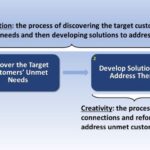6 Steps to Turn Innovation into a Repeatable Business Process
Most people think innovation is inherently risky and messy. That’s not surprising when you consider that 50-90% of all new offerings fail. Yet, study after study has shown that the primary reason for high failure rates is misunderstanding “the customers’ needs, the competitive situation, and the nature of the market¹.” Some experts claim that this misunderstanding accounts for 90% of new business failures². Whatever the percentage may be, these studies tell us that innovation itself is not risky and messy; the way most organizations are going about understanding their target markets is risky and messy.
I have seen this hundreds of times and it still pains me because it doesn’t have to be that way; this is a fixable problem. In fact, virtually any organization that knows what type of customer information to obtain, how to get it, and how to use it, can significantly reduce their market risk (i.e., the risk that people won’t buy what they make), change the game, and achieve dramatically better results. The Jobs-to-be-Done (JTBD) innovation approach enables organizations to do this in six steps.
- Redefine your target market from the customers’ point of view as “a group of people who want to get a core job(s) done in a particular circumstance,” e.g., “hiring managers seeking to hire software engineers,” or “baby boomers seeking to downsize their housing,” etc.
- Interview a diverse set of people in the target market to identify the steps they have to go through to successfully execute the job independent of any product or service solutions. This usually starts with a “planning” step, followed by a “gathering data/materials” step, etc.
- Identify the criteria that target customers use to measure success when executing each step in the job. For example, “Minimize the likelihood of getting into a bidding war for a prospective employee” at the “Negotiate an offer” step of hiring software engineers, or “Minimize the time it takes to determine our housing budget” in the “Planning” step of downsizing, etc. These criteria for success are the “customers’ needs.” But not all needs (criteria) are unmet.
- Determine which criteria the target customers consider to be important to get done and yet are poorly satisfied given their current product/service solution today. The best way to identify and rank the opportunities in the market is by deploying a survey asking target customers to rate each need statement for how important it is to get done and how satisfied they are with their ability to get it done given their current product/service solution. Those needs that are both important and poorly satisfied are opportunities for innovation and growth. The more important and less satisfied a need is, the greater the opportunity for innovation and growth it presents. Getting these ratings makes it possible to identify and rank the biggest opportunities in the market with statistical validity.
- Select which opportunities are most attractive to pursue for new value creation based on your ability to address the need and win in the market. Great new products and growth strategies are formulated by addressing unmet needs with the firm’s relative strengths.
- Devise solution ideas to address the selected opportunities. At this point, because you have already validated the opportunities in the market and selected those opportunities that are most attractive to pursue, you can generate solution ideas with great clarity and confidence because you will know where to focus and what to do to create unique value for your customers. This makes all the difference in the world.This how leading organizations reduce risk, change the game, and achieve dramatically better results. You can, too.
Footnotes:
- The Drivers of Success in New-Product Development, by Robert G. Cooper, Industrial Marketing Management 76, (2019) p. 36-47.
- Nail It Then Scale It, by Nathan Furr and Paul Ahlstrom, NISI Publishing, June 2011, p. 26.
A version of this article was published in The Business Journal as “Ways to Turn Innovation into a Repeatable Business Process.”




